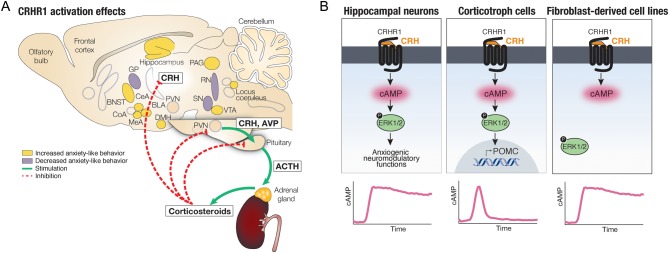Figure 2.
CRH/CRHR1 action at physiological and molecular levels (A) The HPA axis: CRH and AVP secreted from the hypothalamic PVN activate the release of ACTH from pituitary corticotrophs which, in turn, drives the synthesis and release of corticosteroids from the adrenal cortex. Corticosteroids exert a negative feedback on the hypothalamus and pituitary suppressing hormone secretion. CRH expression in extrahypothalamic circuits acts as a neuromodulator orchestrating a complex humoral and behavioral response to stress. The effect of CRHR1 activation on behavior depends on the brain area analyzed. In a sagittal section of the rodent brain, regions associated with increased anxiety-like behavior are shown in yellow and regions associated to reduced anxiety are in gray. It is suggested that a delicate balance between CRHR1-controlled circuits is necessary for a proper stress response and dysregulation of the system may lead to stress-related disorders. BLA, basolateral amygdala; BNST, bed nucleus of the stria terminalis; CeA, central nucleus of the amygdala; CoA, cortical nucleus of the amygdala; DMH, dorsomedial hypothalamus; GP, globus pallidus; MA, medial nucleus of the amygdala; PAG, periaqueductal gray; PVN, paraventricular nucleus of the hypothalamus; RN, raphe nuclei; SN, substantia nigra; VTA, ventral tegmental area. (B) Although CRHR1 activation leads to cAMP rise, the time course of this response and the effectors activated downstream vary according to the cell context. The cAMP response can either be sustained (hippocampal neurons and fibroblast-derived cell lines) or transient (corticotroph cells) and it is only linked to ERK1/2 activation in neuroendocrine or neuronal contexts (hippocampal neurons and corticotroph cells).

 This work is licensed under a
This work is licensed under a 